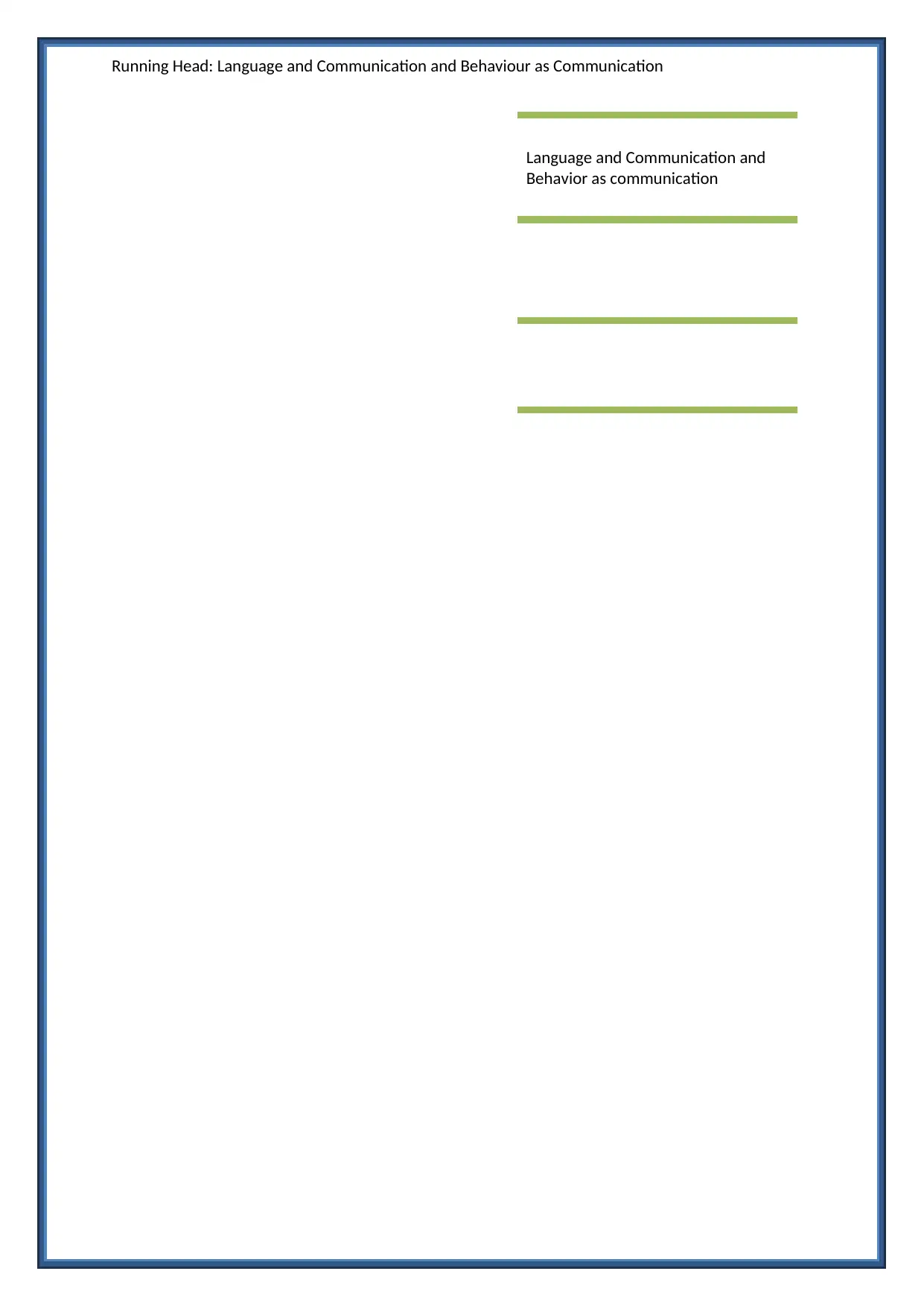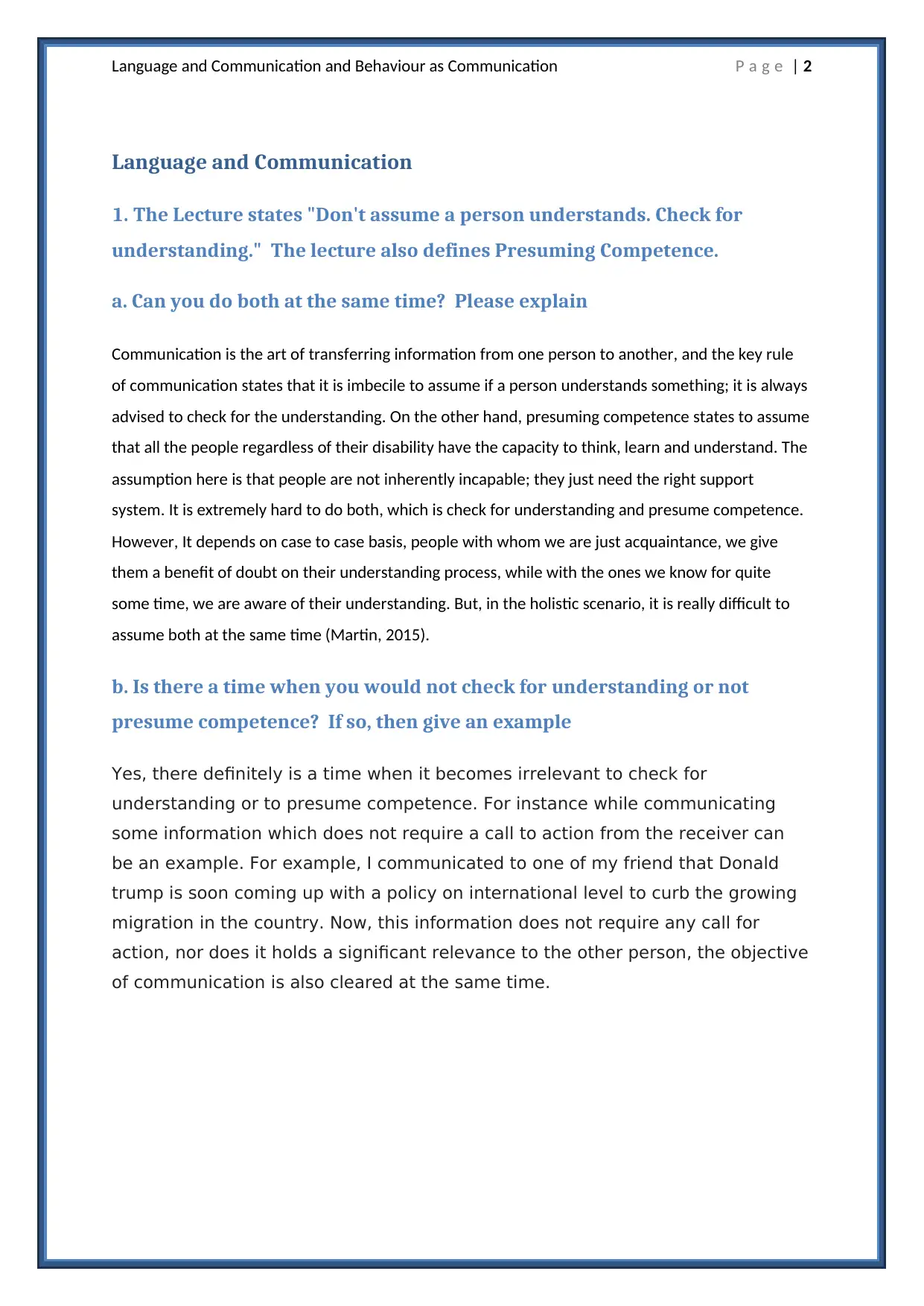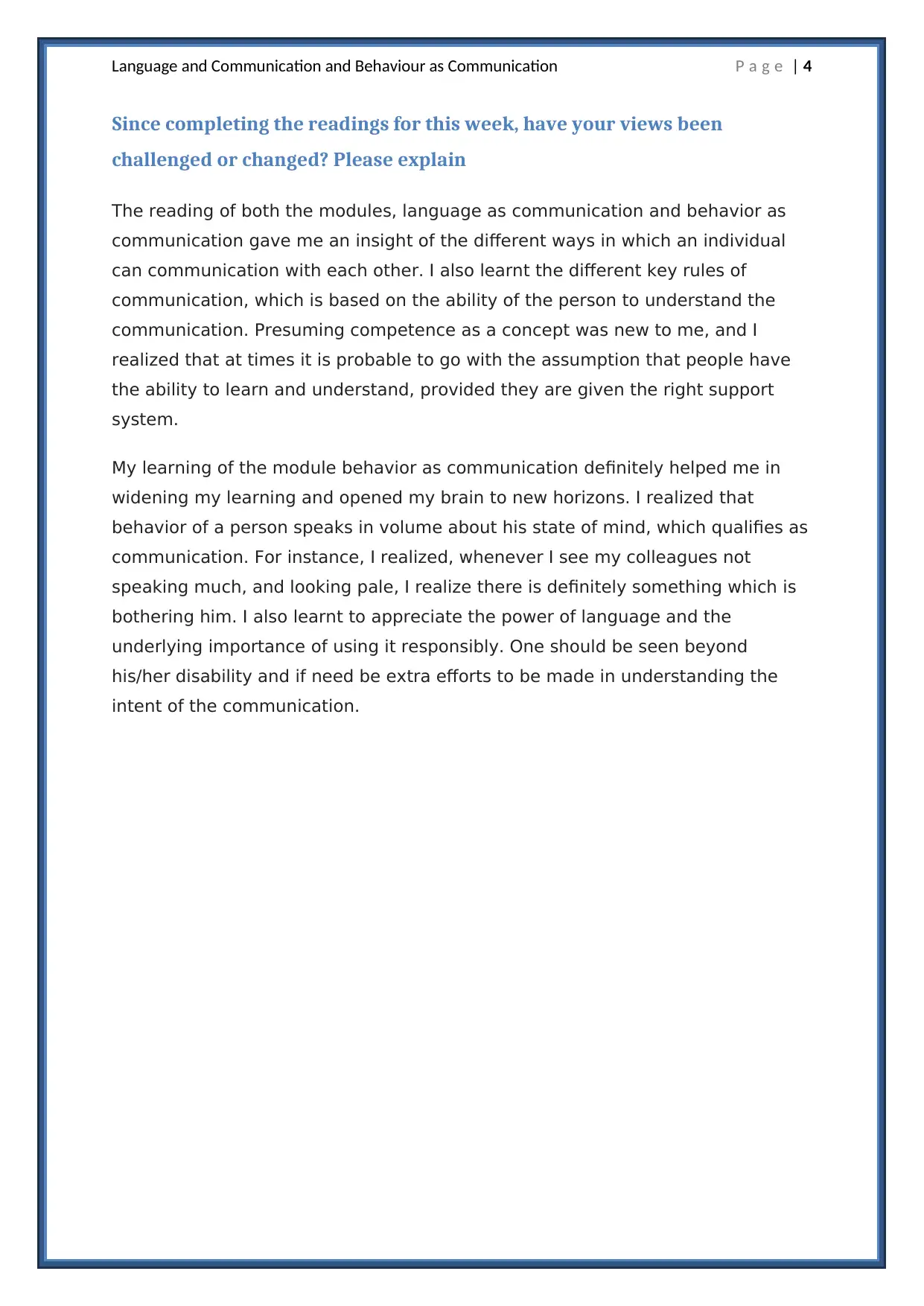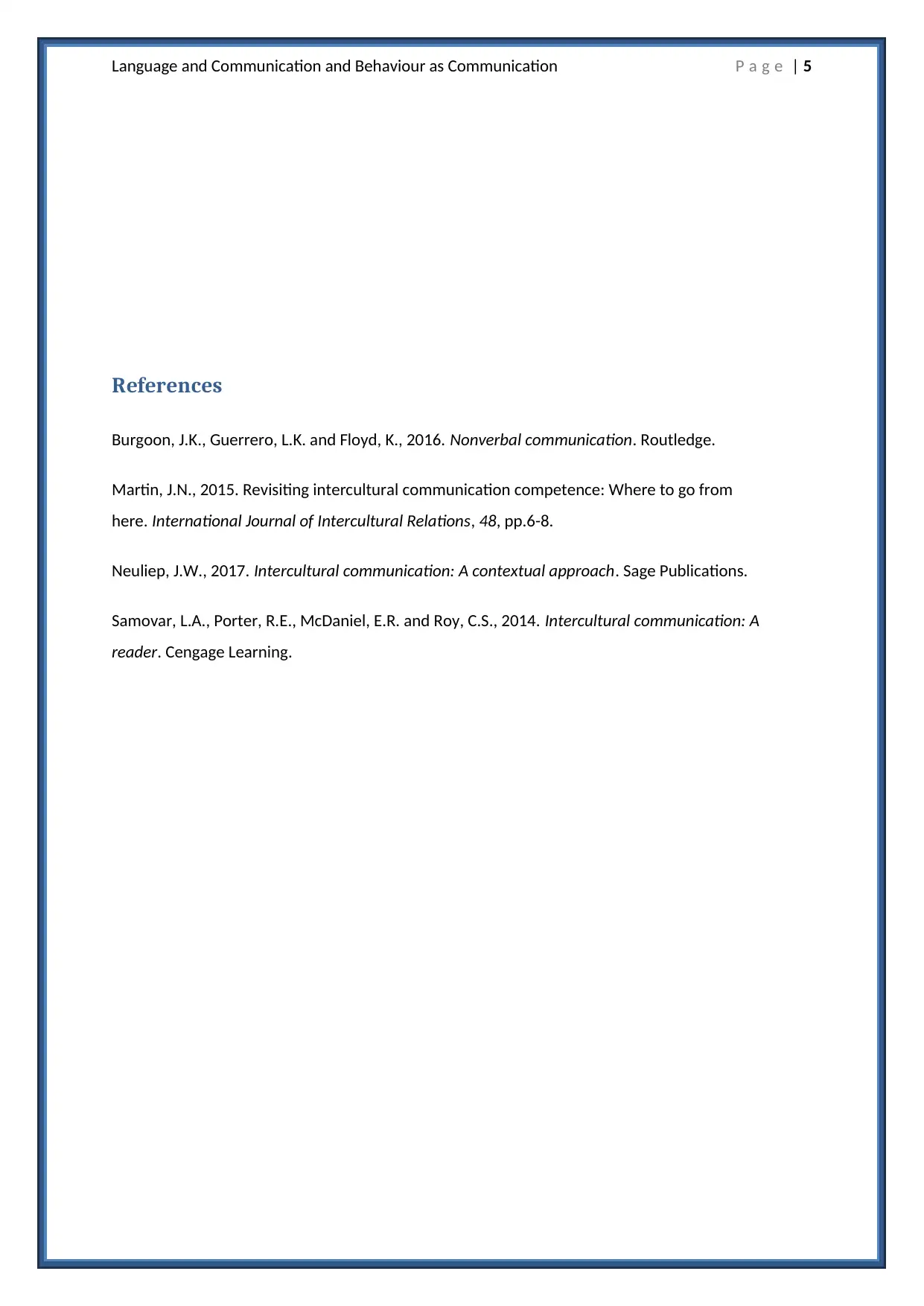Understanding Language, Communication & Behavior in Psychology
VerifiedAdded on 2023/06/10
|6
|1253
|94
Essay
AI Summary
This essay delves into the intricate relationship between language, communication, and behavior, emphasizing the importance of checking for understanding and presuming competence in interactions. It examines how verbal and nonverbal communication techniques can be employed to enhance communication with diverse individuals, including those who may not use speech. The essay also reflects on the author's evolving understanding of behavior as communication, highlighting the significance of responsible language use and the need to appreciate individuals beyond their disabilities. The document is available on Desklib, a platform offering a wealth of study resources for students.

Running Head: Language and Communication and Behaviour as Communication
Language and Communication and
Behavior as communication
Language and Communication and
Behavior as communication
Paraphrase This Document
Need a fresh take? Get an instant paraphrase of this document with our AI Paraphraser

Language and Communication and Behaviour as Communication P a g e | 1
Table of Content
Language and Communication..............................................................................................................2
1. The Lecture states "Don't assume a person understands. Check for understanding." The lecture
also defines Presuming Competence.................................................................................................2
a. Can you do both at the same time? Please explain......................................................................2
b. Is there a time when you would not check for understanding or not presume competence? If
so, then give an example...................................................................................................................2
2. Using information from the Lecture and online articles,...............................................................2
a. Describe how you can encourage or increase communication with someone who is verbal........2
b. Give 2 examples of communication techniques that you can teach someone who is not verbal
and who may not use speech to communicate.................................................................................3
Behavior as Competence.......................................................................................................................3
Please give ideas on your views of behavior, communication and competence?.............................3
Since completing the readings for this week, have your views been challenged or changed? Please
explain...............................................................................................................................................3
References.............................................................................................................................................5
Table of Content
Language and Communication..............................................................................................................2
1. The Lecture states "Don't assume a person understands. Check for understanding." The lecture
also defines Presuming Competence.................................................................................................2
a. Can you do both at the same time? Please explain......................................................................2
b. Is there a time when you would not check for understanding or not presume competence? If
so, then give an example...................................................................................................................2
2. Using information from the Lecture and online articles,...............................................................2
a. Describe how you can encourage or increase communication with someone who is verbal........2
b. Give 2 examples of communication techniques that you can teach someone who is not verbal
and who may not use speech to communicate.................................................................................3
Behavior as Competence.......................................................................................................................3
Please give ideas on your views of behavior, communication and competence?.............................3
Since completing the readings for this week, have your views been challenged or changed? Please
explain...............................................................................................................................................3
References.............................................................................................................................................5

Language and Communication and Behaviour as Communication P a g e | 2
Language and Communication
1. The Lecture states "Don't assume a person understands. Check for
understanding." The lecture also defines Presuming Competence.
a. Can you do both at the same time? Please explain
Communication is the art of transferring information from one person to another, and the key rule
of communication states that it is imbecile to assume if a person understands something; it is always
advised to check for the understanding. On the other hand, presuming competence states to assume
that all the people regardless of their disability have the capacity to think, learn and understand. The
assumption here is that people are not inherently incapable; they just need the right support
system. It is extremely hard to do both, which is check for understanding and presume competence.
However, It depends on case to case basis, people with whom we are just acquaintance, we give
them a benefit of doubt on their understanding process, while with the ones we know for quite
some time, we are aware of their understanding. But, in the holistic scenario, it is really difficult to
assume both at the same time (Martin, 2015).
b. Is there a time when you would not check for understanding or not
presume competence? If so, then give an example
Yes, there definitely is a time when it becomes irrelevant to check for
understanding or to presume competence. For instance while communicating
some information which does not require a call to action from the receiver can
be an example. For example, I communicated to one of my friend that Donald
trump is soon coming up with a policy on international level to curb the growing
migration in the country. Now, this information does not require any call for
action, nor does it holds a significant relevance to the other person, the objective
of communication is also cleared at the same time.
Language and Communication
1. The Lecture states "Don't assume a person understands. Check for
understanding." The lecture also defines Presuming Competence.
a. Can you do both at the same time? Please explain
Communication is the art of transferring information from one person to another, and the key rule
of communication states that it is imbecile to assume if a person understands something; it is always
advised to check for the understanding. On the other hand, presuming competence states to assume
that all the people regardless of their disability have the capacity to think, learn and understand. The
assumption here is that people are not inherently incapable; they just need the right support
system. It is extremely hard to do both, which is check for understanding and presume competence.
However, It depends on case to case basis, people with whom we are just acquaintance, we give
them a benefit of doubt on their understanding process, while with the ones we know for quite
some time, we are aware of their understanding. But, in the holistic scenario, it is really difficult to
assume both at the same time (Martin, 2015).
b. Is there a time when you would not check for understanding or not
presume competence? If so, then give an example
Yes, there definitely is a time when it becomes irrelevant to check for
understanding or to presume competence. For instance while communicating
some information which does not require a call to action from the receiver can
be an example. For example, I communicated to one of my friend that Donald
trump is soon coming up with a policy on international level to curb the growing
migration in the country. Now, this information does not require any call for
action, nor does it holds a significant relevance to the other person, the objective
of communication is also cleared at the same time.
⊘ This is a preview!⊘
Do you want full access?
Subscribe today to unlock all pages.

Trusted by 1+ million students worldwide

Language and Communication and Behaviour as Communication P a g e | 3
2. Using information from the Lecture and online articles,
a. Describe how you can encourage or increase communication with
someone who is verbal.
In order to encourage communication with someone who is verbal, the trick
which always works is talking to the people genuinely, respectfully and subject
which holds relevance to them. Also, good listening skills that are without
interrupting the speaker would further encourage him to speak unabashedly
(Neuliep, 2017).
b. Give 2 examples of communication techniques that you can teach
someone who is not verbal and who may not use speech to communicate.
To a person who is incompetent to communicate using verbal techniques can
communicate using the technique of Gestures, Facial expressions, sign language
and eye gazing (Burgoon, Guerrero & Floyd, 2016).
Behavior as Competence
Please give ideas on your views of behavior, communication and
competence?
It has been seen quite often that we treat people who have conditions, we often
address them as “disabilities” and these people are subjected to devaluation,
marginalization, prejudice and many more. The obvious way in which a person
devalues somebody is through using language, and people use terms such as
“Not like us”, “The other” and many more.
Using the People first language, it is important to put the person before disability
and removing the old and prejudice descriptions set in the earlier times. In
simple words it can be said that our language is responsible for shaping our
attitudes, attitudes shapes language and they intermix.
Competence in the simplest of words is the ability of the person to do something
effectively. For instance, a person who has good communication skills shows
high competency in understanding the message and also while communication
with some other person (Samovar et. al., 2014).
2. Using information from the Lecture and online articles,
a. Describe how you can encourage or increase communication with
someone who is verbal.
In order to encourage communication with someone who is verbal, the trick
which always works is talking to the people genuinely, respectfully and subject
which holds relevance to them. Also, good listening skills that are without
interrupting the speaker would further encourage him to speak unabashedly
(Neuliep, 2017).
b. Give 2 examples of communication techniques that you can teach
someone who is not verbal and who may not use speech to communicate.
To a person who is incompetent to communicate using verbal techniques can
communicate using the technique of Gestures, Facial expressions, sign language
and eye gazing (Burgoon, Guerrero & Floyd, 2016).
Behavior as Competence
Please give ideas on your views of behavior, communication and
competence?
It has been seen quite often that we treat people who have conditions, we often
address them as “disabilities” and these people are subjected to devaluation,
marginalization, prejudice and many more. The obvious way in which a person
devalues somebody is through using language, and people use terms such as
“Not like us”, “The other” and many more.
Using the People first language, it is important to put the person before disability
and removing the old and prejudice descriptions set in the earlier times. In
simple words it can be said that our language is responsible for shaping our
attitudes, attitudes shapes language and they intermix.
Competence in the simplest of words is the ability of the person to do something
effectively. For instance, a person who has good communication skills shows
high competency in understanding the message and also while communication
with some other person (Samovar et. al., 2014).
Paraphrase This Document
Need a fresh take? Get an instant paraphrase of this document with our AI Paraphraser

Language and Communication and Behaviour as Communication P a g e | 4
Since completing the readings for this week, have your views been
challenged or changed? Please explain
The reading of both the modules, language as communication and behavior as
communication gave me an insight of the different ways in which an individual
can communication with each other. I also learnt the different key rules of
communication, which is based on the ability of the person to understand the
communication. Presuming competence as a concept was new to me, and I
realized that at times it is probable to go with the assumption that people have
the ability to learn and understand, provided they are given the right support
system.
My learning of the module behavior as communication definitely helped me in
widening my learning and opened my brain to new horizons. I realized that
behavior of a person speaks in volume about his state of mind, which qualifies as
communication. For instance, I realized, whenever I see my colleagues not
speaking much, and looking pale, I realize there is definitely something which is
bothering him. I also learnt to appreciate the power of language and the
underlying importance of using it responsibly. One should be seen beyond
his/her disability and if need be extra efforts to be made in understanding the
intent of the communication.
Since completing the readings for this week, have your views been
challenged or changed? Please explain
The reading of both the modules, language as communication and behavior as
communication gave me an insight of the different ways in which an individual
can communication with each other. I also learnt the different key rules of
communication, which is based on the ability of the person to understand the
communication. Presuming competence as a concept was new to me, and I
realized that at times it is probable to go with the assumption that people have
the ability to learn and understand, provided they are given the right support
system.
My learning of the module behavior as communication definitely helped me in
widening my learning and opened my brain to new horizons. I realized that
behavior of a person speaks in volume about his state of mind, which qualifies as
communication. For instance, I realized, whenever I see my colleagues not
speaking much, and looking pale, I realize there is definitely something which is
bothering him. I also learnt to appreciate the power of language and the
underlying importance of using it responsibly. One should be seen beyond
his/her disability and if need be extra efforts to be made in understanding the
intent of the communication.

Language and Communication and Behaviour as Communication P a g e | 5
References
Burgoon, J.K., Guerrero, L.K. and Floyd, K., 2016. Nonverbal communication. Routledge.
Martin, J.N., 2015. Revisiting intercultural communication competence: Where to go from
here. International Journal of Intercultural Relations, 48, pp.6-8.
Neuliep, J.W., 2017. Intercultural communication: A contextual approach. Sage Publications.
Samovar, L.A., Porter, R.E., McDaniel, E.R. and Roy, C.S., 2014. Intercultural communication: A
reader. Cengage Learning.
References
Burgoon, J.K., Guerrero, L.K. and Floyd, K., 2016. Nonverbal communication. Routledge.
Martin, J.N., 2015. Revisiting intercultural communication competence: Where to go from
here. International Journal of Intercultural Relations, 48, pp.6-8.
Neuliep, J.W., 2017. Intercultural communication: A contextual approach. Sage Publications.
Samovar, L.A., Porter, R.E., McDaniel, E.R. and Roy, C.S., 2014. Intercultural communication: A
reader. Cengage Learning.
⊘ This is a preview!⊘
Do you want full access?
Subscribe today to unlock all pages.

Trusted by 1+ million students worldwide
1 out of 6
Related Documents
Your All-in-One AI-Powered Toolkit for Academic Success.
+13062052269
info@desklib.com
Available 24*7 on WhatsApp / Email
![[object Object]](/_next/static/media/star-bottom.7253800d.svg)
Unlock your academic potential
Copyright © 2020–2025 A2Z Services. All Rights Reserved. Developed and managed by ZUCOL.





